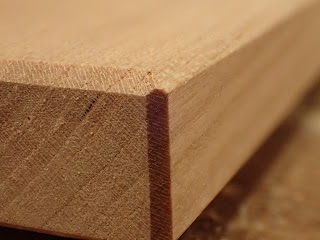I finally got this one done.
 |
| This was supposed to be an anniversary gift to my wife in 2013. |
I don't know what the struggle was, as I said this table was a fun hand tool build. I think it is only that it got interrupted for one reason or another, and when it was time to get back in the shop, there were other things ahead of this in line.
I have a couple projects I am itching to get started, but I made myself focus on this. I am glad I did, because this little table is really nice.
I left off needing to construct the drawer. Appropriate stock I had on hand that was 1/2" thick or less was oak, and this nice scots pine (Pinus sylvestrus). Oak really would look funny with this drawer. Pine should be plenty stout for this.
 |
| Lucky me, this was wide enough to make the drawer bottom with only one glue line. |
This pine was wide, clear, and perfectly quartersawn, which means it should be fairly stable.
For some reason, I goofed up and cut the sides of my drawer 1/2" too short. As a result, this drawer is 1/2" shorter than it ought to be. I can live with that, rather than start over with less appropriate wood.
 |
| I need to learn to clean up after myself in the middle of a project. |
The last drawer I built, I used slips. That was fun, so I thought I would do it again. Besides, this pine was closer to 3/8" than it was 1/2", so grooving slots in it might compromise it's strength.
For some extra overkill, I decided to use ash (Fraxinus excelsior) for the slips. I thought the ash would match the color of the pine inside the drawer, and not detract from the look of the inside of the drawer.
Being lazy, I plowed the groove for my slip stock after having nailed it directly to my bench top. I didn't really have another good option for work holding here without building something else.
 |
| I grooved the whole stick, then cut it in two pieces, one for each side of the drawer. |
Now it's time for dovetails.
 |
| Slips and drawers. Woodworking or Victoria's Secret? |
I have made very good dovetails in the past. These, and the ones on the last drawer I made aren't quite there. I suppose I have to practice this some more.
I also might have to get a better light.
 |
| I used fish glue to glue the slips to the drawer sides. |
Now that the drawer is done, this thing is looking like a finished project!
I used boiled linseed oil as a finished, and no finish at all for the inside of the drawer. I only burnished the wood with a polissoir.
 |
| The bottom actually is a stop that keeps the drawer even with the face. It sticks out so far because I made the drawer too short. |
Here is a good shot of the inside of the drawer. The polissoir makes everything nice and smooth.
 |
| Nice and clean with no knots. |
After a week or so putting on a few more coats of BLO, I will apply some paste wax and set it up with flowers on top, and all manner of crap in the drawer.
I like the top on this one. I found a board that was wide enough that I could glue it up with two boards looking pretty equal.
 |
| For now, it's empty. |
I really like how the drawer is designed to stay up even when it's pulled out as far as it will go.
 |
| Just don't look too close at the dovetails. |
The knob for the front I bought from Lee Valley.
 |
| Artistic photography. |
Hopefully the color will even out a bit over time. I decided against sanding the bits down that have darkened up over time with age. This would have made the color lighter, but also ruined the hand planed finish. I think the only sandpaper I used was some 400 grit on the knob.
 |
| The knob really gives this piece some character. |
Here's my AAR:
- It's probably better to finish the piece right away rather than move it from one part of the shop to the other for years on end. However, finishing it nearly three years late is better than not finishing it at all.
- Cherry darkens over time, even in a shop with no natural light.
- Taking time to lay out the parts on a board with grain flow and pattern in mind is well worth it, even at the expense of way more waste than otherwise.
- Using a handsaw to cut the legs out so the grain is at a 45 degree angle is also well worth the effort. These legs have even, similar grain on all four faces of each leg. Had I not done this, the legs would not have turned out so graceful.
- Tapering legs with a jack plane is a fun and easy hobby you can do at home!
- More of these tables will need to be made to explore new and different things that can be done with the form.
- Christopher Schwarz gets an A+ for his DVD which I used to build this table. I think that an absolute beginner could use this DVD to get good results, assuming he had the proper tools.






















